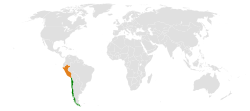This article includes a list of references, related reading, or external links, but its sources remain unclear because it lacks inline citations .(May 2012) |
| Solanum chilense | |
|---|---|
 | |
| Scientific classification | |
| Kingdom: | Plantae |
| Clade: | Tracheophytes |
| Clade: | Angiosperms |
| Clade: | Eudicots |
| Clade: | Asterids |
| Order: | Solanales |
| Family: | Solanaceae |
| Genus: | Solanum |
| Species: | S. chilense |
| Binomial name | |
| Solanum chilense | |
 | |
| It is native to northern Chile, Galápagos, and Peru [2] | |
| Synonyms [2] | |
| |
Solanum chilense is a plant species from the "tomato" subgenus Lycopersicon within the nightshade genus Solanum .
